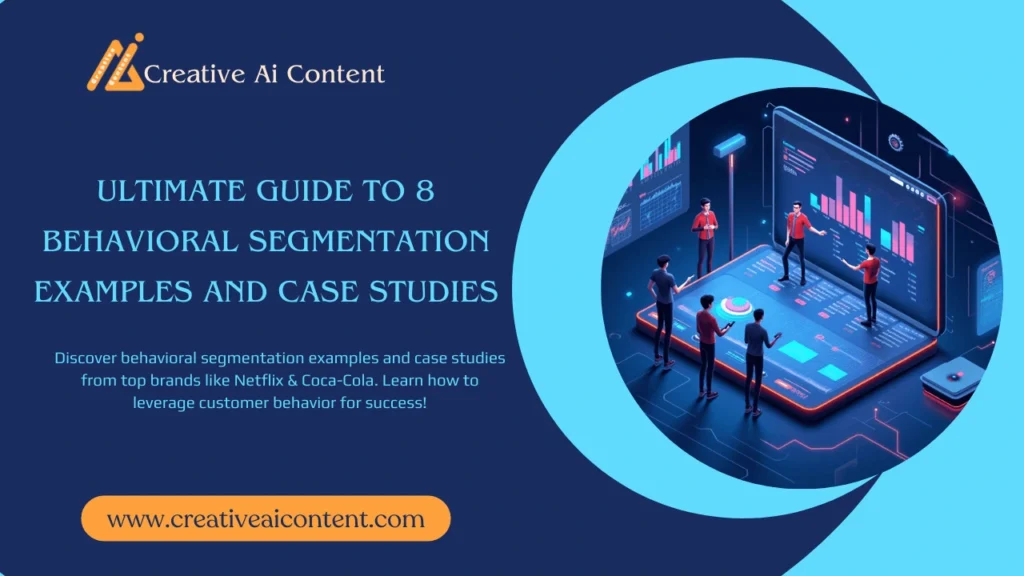Did you know that behavioral segmentation can boost campaign open rates by 12.23% and increase sales growth by 85%? In today’s data-driven world, understanding customer behavior is no longer optional—it’s essential. This comprehensive guide dives into behavioral segmentation examples and case studies, revealing how brands like Netflix, Coca-Cola, and Airbnb use this powerful strategy to personalize experiences, drive loyalty, and maximize ROI. Whether you’re a marketer or business owner, this article will equip you with actionable insights to transform your marketing efforts.

What is Behavioral Segmentation?
Behavioral segmentation is the process of dividing customers into groups based on their actions, preferences, and interactions with a brand. Unlike demographic or geographic segmentation, it focuses on customer behavior patterns, such as purchase history, website engagement, and product usage. This approach allows businesses to deliver hyper-personalized experiences, ensuring the right message reaches the right audience at the right time.
Why Behavioral Segmentation Matters
- Enhanced Personalization: Tailored messaging increases engagement and customer satisfaction.
- Improved ROI: Targeted campaigns reduce wasted ad spend and boost conversions.
- Customer Retention: Understanding behavior helps identify at-risk customers and implement retention strategies.
- Competitive Advantage: Brands that leverage behavioral insights outperform peers in sales and customer loyalty.
Types of Behavioral Segmentation
- Purchase Behavior: Segment customers based on buying frequency, average order value, and product preferences.
- Occasion-Based Segmentation: Target customers during specific events, such as holidays or life milestones.
- Benefits Sought: Group customers by the value they seek, such as quality, convenience, or status.
- Loyalty-Based Segmentation: Identify and reward loyal customers to foster long-term relationships.
Real-World Behavioral Segmentation Examples.
How Top Brands Leverage Customer Behavior
behavioral segmentation examples and case studies
Behavioral segmentation is a powerful tool that allows businesses to understand and cater to their customers’ unique needs and preferences. By analyzing actions such as purchase history, website interactions, and product usage, companies can create highly personalized experiences that drive engagement, loyalty, and revenue. In this section, we’ll explore real-world behavioral segmentation examples from leading brands like Netflix, Coca-Cola, Airbnb, and Starbucks. These case studies demonstrate how behavioral segmentation can be applied across industries to achieve remarkable results.
1. Netflix: Personalized Recommendations Through Viewing Behavior
How They Do It:
Netflix is a pioneer in using behavioral segmentation to enhance user experience. The streaming giant analyzes viewing habits, such as:
- Titles watched
- Time spent on specific genres
- Pause, rewind, and fast-forward actions
- Ratings and reviews
The Result:
Netflix’s algorithm uses this data to create hyper-personalized recommendations for each user. For example, if a user frequently watches romantic comedies, Netflix will prioritize similar titles in their recommendations. This level of personalization has saved Netflix $1 billion annually by reducing churn and increasing viewer engagement.
Key Takeaway:
By segmenting users based on viewing behavior, Netflix ensures that every customer feels understood and valued, leading to higher satisfaction and retention rates.
2. Coca-Cola: Occasion-Based Segmentation for Targeted Campaigns
How They Do It:
Coca-Cola uses occasion-based behavioral segmentation to tailor its marketing efforts. They analyze when and why customers consume their products, such as:
- Holidays and celebrations
- Meal times (e.g., lunch or dinner)
- Weather conditions (e.g., hot summer days)
The Result:
Coca-Cola creates campaigns that resonate with specific occasions. For example, during the holiday season, they run ads featuring families sharing Coca-Cola as part of their celebrations. This approach has helped Coca-Cola maintain its position as one of the most recognized and loved brands globally.
Key Takeaway:
By understanding the context in which customers use their products, Coca-Cola delivers timely and relevant messaging that strengthens emotional connections with their audience.
3. Airbnb: Machine Learning for Perfect Host-Guest Matches
How They Do It:
Airbnb leverages behavioral segmentation to match guests with the perfect hosts. They analyze:
- Search history (e.g., preferred locations, property types)
- Booking behavior (e.g., budget, length of stay)
- Reviews and ratings
The Result:
Airbnb’s algorithm uses this data to recommend properties that align with each guest’s preferences. For example, if a user frequently books eco-friendly accommodations, Airbnb will prioritize similar listings in their search results. This personalized approach has significantly improved user satisfaction and booking rates.
Key Takeaway:
By segmenting users based on their preferences and past behavior, Airbnb creates a seamless and enjoyable experience for both guests and hosts.
4. Starbucks: Loyalty Programs to Drive Repeat Purchases
How They Do It:
Starbucks uses loyalty-based behavioral segmentation to reward its most loyal customers. They track:
- Purchase frequency
- Average order value
- Favorite products
The Result:
Starbucks’ loyalty program, Starbucks Rewards, offers personalized rewards and discounts based on individual behavior. For example, a customer who frequently buys iced coffee might receive a discount on their next iced beverage. This strategy has helped Starbucks achieve a 90% retention rate among loyalty program members.
Key Takeaway:
By segmenting customers based on loyalty and purchase behavior, Starbucks fosters long-term relationships and encourages repeat visits.
5. Amazon: Product Recommendations Based on Purchase and Browsing Behavior
How They Do It:
Amazon is a master of behavioral segmentation, using data such as:
- Products viewed
- Items added to cart
- Purchase history
- Time spent on product pages
The Result:
Amazon’s recommendation engine suggests products that align with each customer’s interests. For example, if a user frequently buys fitness gear, Amazon will recommend related items like protein shakes or workout accessories. This approach has contributed to 35% of Amazon’s total revenue coming from personalized recommendations.
Key Takeaway:
By analyzing browsing and purchase behavior, Amazon creates a highly personalized shopping experience that drives sales and customer satisfaction.
6. Spotify: Curated Playlists Based on Listening Habits
How They Do It:
Spotify uses behavioral segmentation to analyze listening habits, such as:
- Genres and artists frequently played
- Time of day when users listen to music
- Playlists created or followed
The Result:
Spotify creates personalized playlists like “Discover Weekly” and “Daily Mix” based on each user’s preferences. For example, if a user listens to a lot of jazz music, Spotify will curate a playlist featuring new jazz tracks and artists. This strategy has helped Spotify grow its user base to over 500 million active users.
Key Takeaway:
By segmenting users based on listening behavior, Spotify delivers a unique and engaging experience that keeps users coming back.
7. Sephora: Personalized Beauty Recommendations
How They Do It:
Sephora uses behavioral segmentation to analyze:
- Products purchased
- Items added to wishlists
- Reviews and ratings
The Result:
Sephora’s Beauty Insider program offers personalized product recommendations and rewards based on individual behavior. For example, a customer who frequently buys skincare products might receive samples of new skincare items. This approach has helped Sephora build a loyal customer base and increase sales.
Key Takeaway:
By understanding customer preferences and behavior, Sephora creates a tailored shopping experience that enhances customer satisfaction and loyalty.
8. Uber: Dynamic Pricing Based on Demand Behavior
How They Do It:
Uber uses behavioral segmentation to analyze:
- Peak usage times
- Popular routes
- Surge pricing patterns
The Result:
Uber adjusts pricing dynamically based on demand behavior. For example, during rush hour or bad weather, prices may increase to incentivize more drivers to be available. This strategy ensures reliable service while maximizing revenue.
Key Takeaway:
By segmenting users based on demand behavior, Uber optimizes its operations and delivers a consistent experience for riders and drivers.
These real-world behavioral segmentation examples highlight the transformative power of understanding customer behavior. From Netflix’s personalized recommendations to Starbucks’ loyalty programs, brands across industries are leveraging behavioral data to create meaningful connections with their audiences. By adopting similar strategies, businesses can enhance customer experiences, drive loyalty, and achieve sustainable growth.

How to Implement Behavioral Segmentation
Step 1: Collect Data
Gather data from multiple sources, including website analytics, CRM systems, and social media interactions.
Step 2: Analyze Behavior
Use tools like Google Analytics or AI-powered platforms to identify patterns and segment customers7.
Step 3: Create Targeted Campaigns
Develop personalized messaging and offers for each segment. For example, retarget cart abandoners with discounts.
Step 4: Monitor and Optimize
Track campaign performance and refine segments based on real-time data.
How to Implement Behavioral Segmentation
Step 1: Collect Data
Gather data from multiple sources, including website analytics, CRM systems, and social media interactions.
Step 2: Analyze Behavior
Use tools like Google Analytics or AI-powered platforms to identify patterns and segment customers.
Step 3: Create Targeted Campaigns
Develop personalized messaging and offers for each segment. For example, retarget cart abandoners with discounts.
Step 4: Monitor and Optimize
Track campaign performance and refine segments based on real-time data.
Conclusion
Behavioral segmentation is a game-changer for businesses aiming to deliver personalized experiences and drive growth. By understanding customer behavior, brands like Netflix, Coca-Cola, and Airbnb have set new standards for engagement and loyalty. Ready to transform your marketing strategy? Start leveraging behavioral segmentation examples and case studies today and watch your business thrive.
Share your thoughts in the comments or explore more insights in our related articles!
Related Articles
- How Netflix Uses Behavioral Segmentation to Dominate Streaming
- The Ultimate Guide to Customer Behavior Analysis
- 5 Steps to Implement Behavioral Segmentation in Your Business
FAQs
Sources
- Hurree – Behavioral Segmentation: 3 Case Studies [https://blog.hurree.co/behavioral-segmentation]
- CleverTap – What is Behavioral Segmentation? [https://clevertap.com/blog/behavioral-segmentation/]
- LeadSquared – Behavioral Segmentation Guide [https://www.leadsquared.com/learn/sales/behavioral-segmentation-guide/]
- Eminence – Behavioral Segmentation in Marketing [https://eminence.ch/en/behavioral-segmentation-in-marketing/]
- WordStream – 13 Behavioral Segmentation Strategies [https://www.wordstream.com/blog/ws/2017/08/28/behavioral-segmentation]
